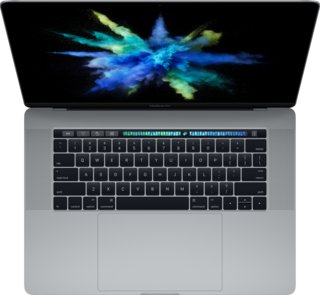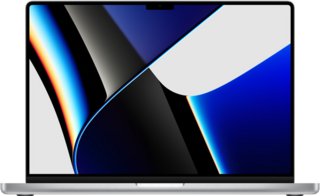Apple MacBook Pro (2016) 15" with Touch Bar and Touch ID vs Apple MacBook Pro (2021) 16.2" Apple M1 Max
Come along on a journey as we compare Apple's MacBook Pro models from 2016 and 2021. The 2016 model, a favorite among tech enthusiasts, had a unique 15-inch display and a touch-sensitive toolbar known as the Touch Bar and Touch ID. This feature allowed for quick command inputs, making it a breeze to use. Plus, it boasted an elegant and portable design that was perfect for individuals constantly on the go. On the performance front, it smoothly handled daily tasks and creative projects with moderate demands.
In 2021, the MacBook Pro received a significant upgrade to a 16.2-inch screen - ideal for precise work. The true breakthrough was the M1 Max Chip that delivered outstanding speed and power to this model. Paired with an impressive memory and storage capacity of 32GB RAM and 1TB SSD, it elevated multitasking and large file handling capabilities.
Performance-wise, there's no contest - the M1 Max Chip in the 2021 model far surpasses the 2016 version for intensive tasks like video editing or 3D rendering. The higher RAM and storage in the latest model further enhance its multitasking efficiency and capacity to handle larger files. Regarding design & usability, both models maintain Apple's signature sleekness, but the larger display in the newer version can boost productivity.
Whether you're seeking a power-packed machine for your creative pursuits or a dependable partner for daily tasks, understanding these differences can guide you towards the MacBook Pro that aligns best with your requirements.
System and application performance
Performance in popular 3D games
Viewing angle, color accuracy...
Ports, webcam and other interfaces
Potential battery life
Materials, durability and portability
Design Comparison
Size Comparison
Comparing the Apple MacBook Pro (2016) 15" with Touch Bar and Touch ID to the Apple MacBook Pro (2021) 16.2", it's clear that each model presents unique design features that improve the user experience in their own way.
Design Elements:
Ergonomics:The screen size of the 2021 model has been increased from 15.4 inches to 16.2 inches, offering users additional screen space for easier multitasking and content creation.- Both laptops have backlit keyboards, making it easier to use in low-light settings for long periods.
Materials and Build Quality:- Apple ensures top-notch build quality for both models by utilizing premium materials such as aluminum to achieve a sleek and long-lasting finish.
Portability:- The newer model weighs 4.9 pounds, slightly more than the previous 4 pounds, yet it still offers high portability for users who are frequently on the move.The 2021 model features a thinner profile of just 0.7 inches, providing a sleeker look while maintaining structural strength.
Unique Design Features:The 2021 model offers increased connectivity options with an HDMI output, USB ports, external memory slot, and extra Thunderbolt ports.The newer model includes MagSafe power adapters, offering added convenience and safety benefits over traditional charging methods.
Influence on Practical Usability and Aesthetic Appeal:
For Students:
- The larger screen size of the 2021 model may benefit students who require more screen space for research, writing papers, or multimedia projects.
- Enhanced connectivity options in the newer model cater to students who need to connect various devices simultaneously.
For Professionals:
- Professionals may appreciate the improved port selection on the 2021 model for increased productivity when working with external displays or accessories.
- The thinner profile and premium design language of both models maintain a professional aesthetic suitable for workplace environments.
Conclusion:
In conclusion, both MacBook Pro models boast unique design features that enhance user experience. When deciding between them, potential buyers should consider their specific needs. Students might lean towards the 2021 model for its larger screen size and improved connectivity, whereas professionals could find the enhanced port selection beneficial.
Screen Comparison
| Apple MacBook Pro (2016) 15" with Touch Bar and Touch ID | Apple MacBook Pro (2021) 16.2" Apple M1 Max | |
|---|---|---|
| Resolution | QHD | QHD |
| Screen Size | 15.4" | 16.2" |
Screen Comparison: Apple MacBook Pro (2016) 15" vs. Apple MacBook Pro (2021) 16.2
Screen Size:
- The MacBook Pro (2016) has a 15.4-inch screen, while the MacBook Pro (2021) sports a larger 16.2-inch display.Impact on User Experience: A bigger screen can improve multitasking, offer additional space for content creation tasks such as video editing or graphic design, and provide a more immersive gaming experience.
Resolution:
- The MacBook Pro (2016) has a resolution of 2880 x 1080 pixels, while the MacBook Pro (2021) boasts a resolution of 3456 x 1080 pixels.Impact on User Experience: Increased resolution improves image quality, enhances text sharpness, and provides clearer visuals for activities such as photo editing or enjoying high-definition content.
Pixel Density:
- The MacBook Pro (2016) features a pixel density of 220 pixels per inch (ppi), whereas the MacBook Pro (2021) offers a higher pixel density of 254 ppi.User Experience Enhancement: Increased pixel density enhances graphics and text sharpness, resulting in smoother visuals with finer details. This improvement benefits professionals handling detailed designs and gamers who prioritize high-quality visuals.
Display Technology:
- The MacBook Pro (2016) has an IPS LCD LED-backlit display, whereas the MacBook Pro (2021) comes with an improved LED-backlit LCD display boasting a brightness of 1600 nits.User Experience Improvements: Enhanced display technology can result in more accurate colors, broader viewing angles, and higher brightness levels, particularly beneficial for outdoor settings or tasks that demand vivid colors such as video editing or gaming.
Supported Displays:
- The MacBook Pro (2016) can connect to three external displays, while the MacBook Pro (2021) enhances this feature by allowing connection to four external displays.
- User Experience Impact: Improved compatibility with more external displays can be advantageous for professionals who use multiple applications at once or gamers looking to create larger setups for immersive gameplay experiences.
Conclusion:
- Gaming and Graphic Design: The MacBook Pro (2021) provides a more immersive visual experience with its larger screen size, higher resolution, superior pixel density, and improved display technology than the MacBook Pro (2016). Professionals in graphic design or gamers seeking enhanced visual performance would find the newer model's upgraded screen features beneficial.
Hardware Comparison
| Apple MacBook Pro (2016) 15" with Touch Bar and Touch ID | Apple MacBook Pro (2021) 16.2" Apple M1 Max | |
|---|---|---|
| RAM | 16GB | 32GB |
| Storage Size | 2000GB | 1000GB |
When comparing the Apple MacBook Pro (2016) 15" with Touch Bar and Touch ID to the Apple MacBook Pro (2021) 16.2" equipped with Apple M1 Max, 32GB RAM, and a 1TB SSD, we delve into a detailed hardware analysis.
We're comparing the hardware features of the Apple MacBook Pro (2016) 15" with Touch Bar and Touch ID against the Apple MacBook Pro (2021) 16.2", which comes with the powerful Apple M1 Max chip, 32GB RAM, and a spacious 1TB SSD storage.
CPU Comparison:
- Apple MacBook Pro (2016):
- CPU Speed: 4 GHz
- Semiconductor Size: 14 nm
- Apple MacBook Pro (2021):
- CPU: Apple M1
- Cpu Speed: 8 GHz
- Semiconductor Size: 5 nm
Improvement in Performance: The 2021 model of Apple features an upgraded M1 chip with a faster clock speed and a more advanced semiconductor size, resulting in significantly improved performance efficiency compared to its predecessor. This enhanced processing capability leads to quicker task completion, seamless multitasking, and enhanced overall system responsiveness.
GPU Comparison:
- Apple MacBook Pro (2016):
- Internal Graphics Card
- Apple MacBook Pro (2021):
- Integrated Graphics
- Number of Transistors: 57000
Performance Impact: The Apple MacBook Pro (2021) enhances graphical capabilities with its integrated graphics, surpassing the older model's internal graphics card. This advancement is especially advantageous for users involved in multimedia tasks, graphic design projects, or gaming, delivering improved visuals and quicker rendering speeds.
RAM Comparison:
- Apple MacBook Pro (2016):
- Maximum Memory Amount: 16GB
- RAM: 16GB
- Apple MacBook Pro (2021):
- Maximum Memory Amount: 64GB
- RAM: 32GB
Performance Boost: The newer model's expanded memory capacity enables smoother multitasking and seamless operation of resource-intensive applications, enhancing productivity for users handling demanding tasks or heavy software on the Apple MacBook Pro (2021).
Storage Comparison:
- Apple MacBook Pro (2016):
- Uses Flash Storage
- Internal Storage: 2000GB
- Apple MacBook Pro (2021):
- Uses Flash Storage
- Internal Storage: 1000GB
Performance Impact: Both laptops incorporate flash storage for quick data access and system responsiveness. Despite the newer model having a lower storage capacity, improved storage technology guarantees swift data transfer speeds and effective file organization for users managing large media files or running resource-intensive applications.
In conclusion, when deciding between these two models, the Apple MacBook Pro (2021) stands out for its significant hardware improvements in essential components like the CPU, GPU, RAM, and storage. These upgrades result in enhanced performance suitable for various users, from multimedia enthusiasts to professionals needing powerful computing capabilities.
Consider your individual needs when choosing a device that meets your processing power, graphics performance, multitasking capabilities, and storage requirements. The Apple MacBook Pro (2021) is a top choice for users who want advanced hardware features that provide outstanding performance for a wide range of tasks and applications.
Battery Comparison
| Apple MacBook Pro (2016) 15" with Touch Bar and Touch ID | Apple MacBook Pro (2021) 16.2" Apple M1 Max | |
|---|---|---|
| Battery Life | 10 hours | 14 hours |
Comparing the battery life of the Apple MacBook Pro (2016) 15" with Touch Bar and Touch ID to the Apple MacBook Pro (2021) 16.2" Apple M1 Max model reveals significant differences.
Apple MacBook Pro (2016) 15" with Touch Bar and Touch ID:- Battery Life: 10 hours
Apple MacBook Pro (2021) with 16.2" Display, Apple M1 Max Chip, 32GB RAM, and 1TB SSD:- Battery Life: 14 hours
- Sleep And Charge USB Ports: true
- MagSafe Power Adapter: true
The newer Apple MacBook Pro (2021) boasts a longer battery life, providing up to 14 hours of usage compared to the 10 hours offered by the Apple MacBook Pro (2016). This enhanced battery performance is beneficial for users needing prolonged productivity without frequent recharges.
The addition of Sleep And Charge USB Ports and a MagSafe Power Adapter in the MacBook Pro (2021) boosts its convenience and flexibility. Being able to charge devices via USB ports while the laptop is in sleep mode is highly practical for users who require on-the-go accessory charging. Moreover, the MagSafe Power Adapter guarantees safe and efficient charging without sacrificing user experience.
If battery life is a key consideration for you, the Apple MacBook Pro (2021) could be a suitable choice. With up to 14 hours of battery life and features such as Sleep And Charge USB Ports and a MagSafe Power Adapter, it can enhance your daily computing experience with added convenience and flexibility.
Verdict
Why Apple MacBook Pro (2016) 15" with Touch Bar and Touch ID?
- If you prefer a smaller and more portable laptop design.
- For those who prioritize having more internal storage capacity.
- If the Touch Bar feature is a must-have for your workflow.
Why ?
- Improved performance with M1 Max chip for intensive tasks like video editing and 3D rendering.
- Enhanced memory and storage capacity for better multitasking and large file handling.
- Larger 16.2-inch display for detailed work and improved productivity.
- Longer battery life of up to 14 hours for extended usage without frequent recharges.
Similar comparisons
- Apple MacBook Pro (2016) 15" with Touch Bar and Touch ID vs Apple MacBook Pro (2020) 13.3" Apple M1
- Apple MacBook Pro (2016) 13" vs Microsoft Surface Pro 7 12.3" Intel Core i7-1065G7
- Apple MacBook Pro (2016) 13" vs Microsoft Surface Laptop 4 15" Intel Core i7-1185G7
- Apple MacBook Air (2017) 13.3" Intel Core i5 128GB vs Apple MacBook Pro (2016) 13" with Touch Bar and Touch ID
- Apple MacBook Pro (2016) 13" vs Microsoft Surface Laptop 3 13.5"

